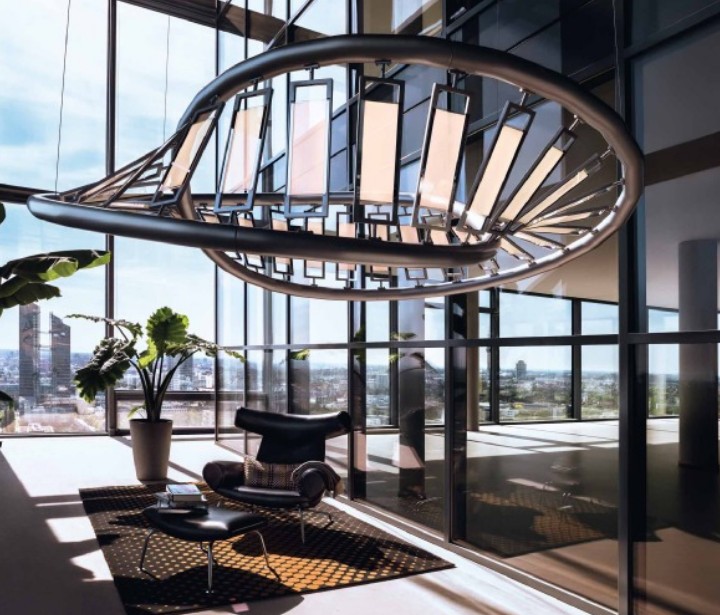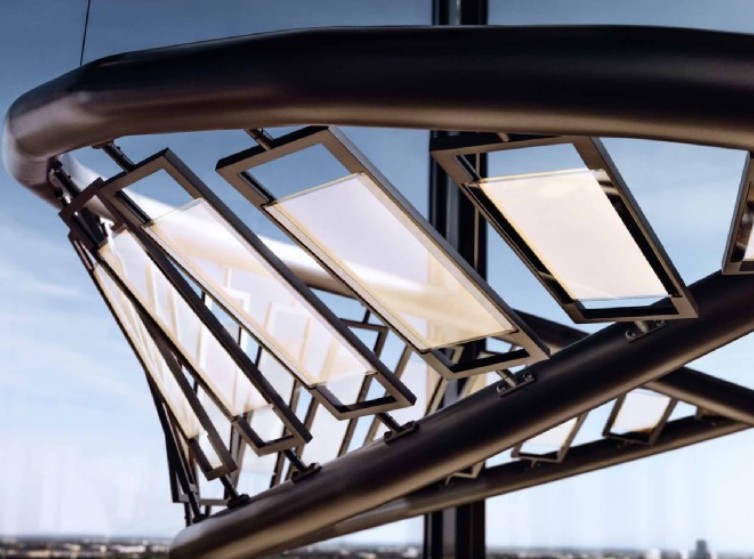The 'Rollercoaster' luminaire demonstrates rapid development with organic light emitting diodes
Osram presents a luminaire in the form of the Rollercoaster designer luminaire featuring industry-mature, transparent OLEDs for the first time. The 'luminous glass panels' are intended for series-production from 2014 onwards, and OLED will be the first choice in the future for transparent light designs.
Osram presents a luminaire in the form of the Rollercoaster designer luminaire featuring industry-mature, transparent OLEDs for the first time. The 'luminous glass panels' are intended for series-production from 2014 onwards, and organic light emitting diodes will be the first choice in the future for transparent light designs.

The luminaire has the appearance of a glass and metal sculpture in switched-off state and is transformed into a luminous element of design when switched on, reminiscent of a roller-coaster with its möbius form. The 30 wide-area light sources within were developed as part of the TOPAS2012 research project supported by the German Federal Ministry of Education and Research, and each have a luminous surface of 18 x 6.5 centimetres. Efficiency of 20 lm/W with a transmission ('transparency') of 57% was achieved for the first time for transparent OLEDs of this size. "The next step for transparent OLEDs is industrial series production, and we'll be tackling that in 2014," remarked Ulrich Eisele, responsible for the OLED sector at Osram. OLEDs have no visible conducting path and feature secure encapsulation, until now a major deficiency with the transparent light source. New is also the possibility of defining a specific light distribution side with the transparent OLEDs featuring distribution on both sides: in the one direction the light merely has a decorative function as it is weaker, but in the other it can be used functionally, for purposes of illumination. OLEDs in this way unite the photometric benefits of both direct and indirect lighting. Panels and the luminaire itself were developed at the Osram location of Regensburg in Germany.

New designs possible
OLEDs are expected to be the primary choice for transparent, wide-area light sources in the future, because in contrast to LED they emit wide-area light directly, so that efficiency losses from the conversion of 'point-sourced' to 'wide-area' light no longer occur. In addition, OLEDs are not dim but absolutely brilliant and clear. They thus enable room partitions that when switched off are similar to transparent glass and in switched-on state light up opaquely. Mosaic windows that radiate without sunlight in the background also become possible. Another option might also be a luminous car canopy.
Ready for series production in 2014
"After achieving a record this year with temperature stability, we're certainly pleased about this second important success in our research," said Eisele. Following on from the TOPAS2012 project, the current Federal Ministry of Education and Research project called GENESIS is a scaling down to manufacture-compliant processes and substrate sizes. Glass substrates sourced from Saint-Gobain are used based on the new Silverduct technology, and these enable lower cost production compared to earlier processes.
Luminous semiconductors
Technically speaking, OLEDs, as with LEDs, are semiconductors that convert electric current to light. While LEDs emit point light from a tiny luminous chip, OLED panels are luminous surfaces produced by vaporizing various organic plastics onto a substrate material. The luminous layer of an OLED is approximately 400 nanometres thick, corresponding to one hundredth of a human hair. OLEDs according to base material appear reflective, neutral white or transparent in switched-off state.













